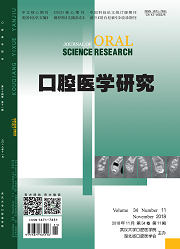|
|
Long-term Effects of Three Orthodontic Appliances on Periodontal Inflammation and Inflammatory Factors in Gingival Crevicular Fluid
ZUO Zhi-gang, LI Hong-fa, XU Jin, ZHENG Zhao, WU Jie, LIU Da-yong
2018, 34(11):
1223-1227.
DOI: 10.13701/j.cnki.kqyxyj.2018.11.018
Objective: To compare the long-term effects of orthodontic brackets without brackets, self-ligating brackets, and traditional metal bracket appliances on patients' oral hygiene. Methods: 30 patients with orthodontics treatment in our hospital from March 2015 to December 2015 were selected. The average age was 21.20±2.15 years old. After the patient completely cleaned up plaque and calculus, Invisalign, DAMON Q, and the traditional metal bracket appliance (Victory Series) were used. After 1, 3, 6, 12, 18, and 24 months, the patients' gingival index, sulcus bleeding index, calculus index, debris index, and gingival crevicular fluid IL-1β and TNF-α were measured. Results: There was no significant difference in gender, age, Angle class distinction, and periodontal index between the groups (P>0.05). After 3 months of treatment, the periodontal index of each group increased compared with baseline (P<0.05). No significant difference was found except for the debris index (P>0.05). From 6 to 12 months, The periodontal index of the lock bracket and the traditional bracket group was significantly higher than that of the invisible group (P<0.05). After 18 months, there was no significant difference in the gin- gival index and sulcus bleeding index between three groups (P>0.05). The expression of IL-1β and TNF-α in the three groups from January to September was significantly increased (P<0.05). After 9 months, the expression of the invisible group tended to be stable, and the difference was not statistically significant (P>0.05). The expressions of the trough group and the traditional bracket group were higher from September to December and then decreased gradually. There was no significant difference between the trough and the invisible group after 24 months (P>0.05). Conclusion: This study observed the long-term effects of three appliances on oral hygiene, confirming that the invisible appliance with or without brackets contributes to oral hygienic preservation during the initial correction period. However, after 18 months of orthodontic treatment, the effect is not obvious.
References |
Related Articles |
Metrics
|

